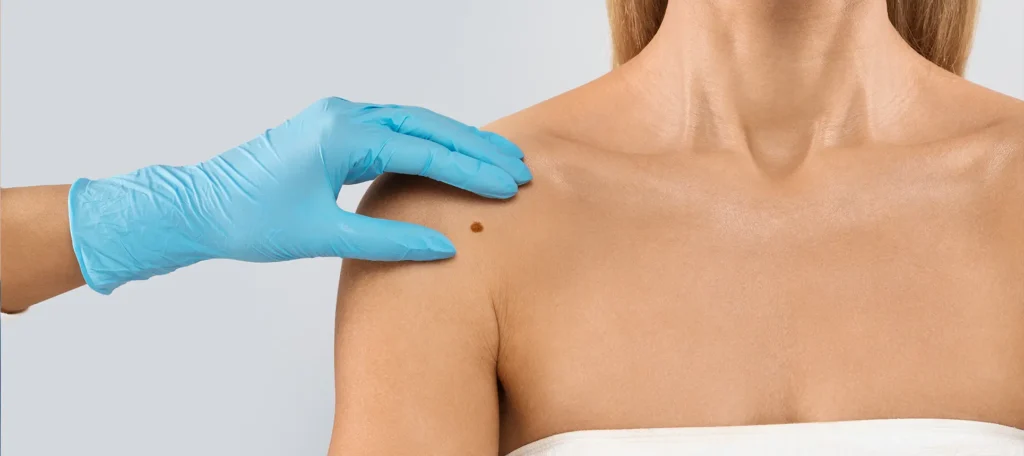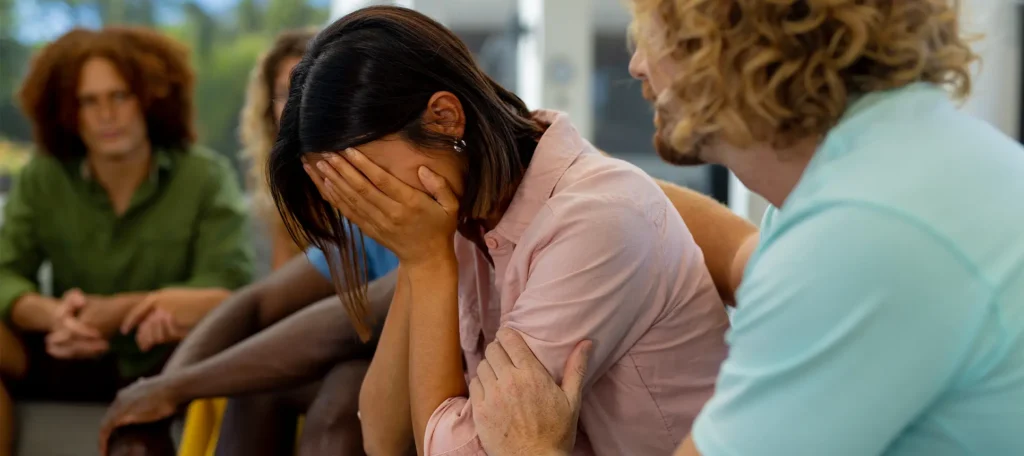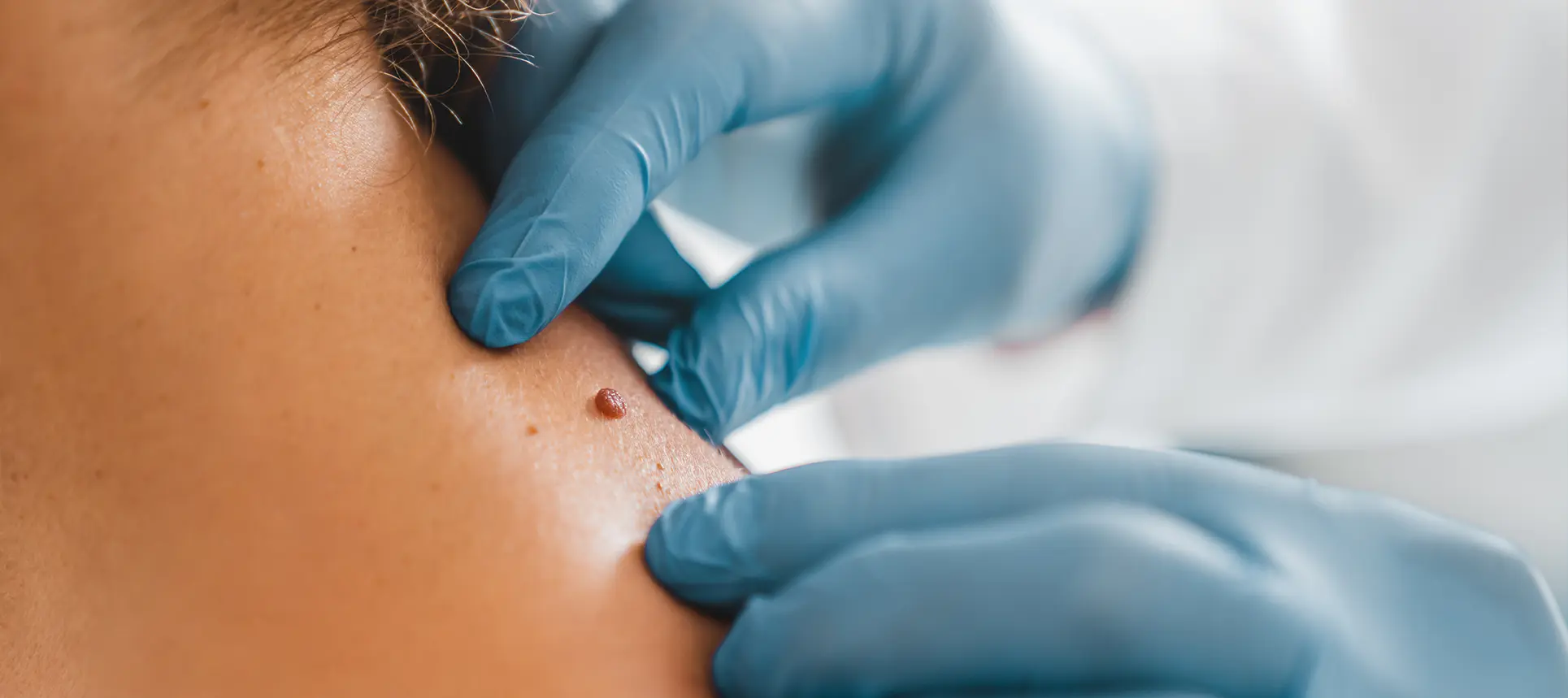Skin growths are incredibly common, and most of the time, they’re completely harmless. But if you’ve ever noticed a new bump or lump on your skin, you’ve probably asked yourself: “Is this a wart, a mole, or a skin tag?” Understanding what you’re dealing with is the first step to deciding whether to leave it alone or seek treatment. In this article, we’ll walk you through how to tell these growths apart, when to see a professional, and what removal options are available if it’s bothering you. From texture and colour to location and behaviour, we’ll demystify these common skin conditions—so you can take the right action with confidence.
1. What Are Warts?
Warts are small, rough skin growths caused by the human papillomavirus (HPV). They’re contagious and can spread from person to person or from one area of the body to another. Warts are most often found on the hands, fingers, feet (known as verrucas), and knees, but they can appear anywhere. They’re usually rough, grainy, and flesh-coloured, sometimes with a black dot in the centre, which is a clotted blood vessel. Warts tend to be more common in children and people with weakened immune systems. Because they’re caused by a virus, they may resolve on their own over time—but they can also be persistent and multiply. Treatment options include over-the-counter salicylic acid preparations, cryotherapy (freezing), or minor procedures carried out by dermatologists.
2. Understanding Moles (Melanocytic Naevi)
Moles are clusters of pigmented skin cells (melanocytes) that appear as brown, black, or flesh-toned spots on the skin. They can be flat or raised, and while many people have between 10 and 40 moles, most are entirely benign. However, because moles involve pigment-producing cells, they have the potential—albeit small—to develop into melanoma, a form of skin cancer. That’s why it’s important to keep an eye on any mole that changes in size, shape, colour, or texture. The ABCDE rule (Asymmetry, Border, Colour, Diameter, Evolving) is a useful guide for spotting potential issues. Moles that become itchy, bleed, or develop irregular borders should be examined by a GP or dermatologist. While most moles don’t require removal, they can be excised for cosmetic reasons or if there’s suspicion of malignancy.
3. What Are Skin Tags?
Skin tags, also known as acrochordons, are small, soft, flesh-coloured growths that hang off the skin. They’re not dangerous, contagious, or cancerous—and they don’t usually change in size or appearance. Skin tags often develop in areas where skin rubs against skin or clothing, such as the neck, underarms, eyelids, or groin. They’re more common in older adults, people who are overweight, and those with diabetes. Although they’re harmless, they can be a nuisance if they catch on jewellery or clothing. Skin tag removal is generally a simple procedure carried out in a clinic, and can involve freezing (cryotherapy), snipping with sterile scissors, or cauterisation. Since they’re benign, treatment is often elective.

4. Key Differences Between Warts, Moles, and Skin Tags
While all three may appear as small lumps on the skin, there are distinct features that help differentiate them. Warts tend to be rough, grainy, and may have a speckled centre. Moles are usually uniform in colour (though some may be darker), and can be flat or slightly raised. Skin tags, on the other hand, are soft, often pedunculated (on a stalk), and move easily when touched. Another clue lies in location: warts often appear on hands or feet, skin tags in friction-prone areas, and moles virtually anywhere. Unlike warts, moles and skin tags aren’t contagious. And while skin tags and warts are generally harmless, moles—especially changing ones—require a bit more attention due to their potential to become cancerous.
5. When to See a Professional
Although most benign skin growths are nothing to worry about, there are certain warning signs you shouldn’t ignore. If a mole changes shape, becomes asymmetrical, or has multiple colours, it’s time to get it checked. Any bleeding, itching, or crusting is also a red flag. For warts that persist, spread, or become painful, professional treatment may be needed. Likewise, if a skin tag becomes irritated or inflamed, especially in a sensitive area, you might benefit from removal. A GP or dermatologist can offer a proper diagnosis, especially if you’re unsure what you’re dealing with. In some cases, they may take a biopsy to rule out more serious conditions.
6. Common Myths and Misconceptions
There are many myths surrounding skin growths. One of the most common is that cutting off a skin tag at home is safe. While technically possible, it’s risky and unhygienic. Another myth: all moles are dangerous. In truth, most moles are benign and don’t require removal unless they’re causing concern. Some people also believe warts have “roots,” which isn’t accurate—they only grow in the upper layers of skin. Importantly, attempting to treat an unknown lesion without knowing what it is can be dangerous. What appears to be a wart or skin tag could be a basal cell carcinoma or early melanoma in disguise. Always err on the side of caution.
7. Safe Removal Options: What to Expect
When it comes to removing benign skin growths, safety and sterility are key. Removal should be done in a clinical setting, especially for moles or growths that have changed in appearance. For warts, cryotherapy is a common option and involves freezing the wart off using liquid nitrogen. Other treatments include topical salicylic acid, laser therapy, or minor surgery. Skin tag removal is typically straightforward—either by cauterising, cutting, or freezing. Mole removal, if needed, is usually done by surgical excision with or without stitches, depending on the depth. Healing times vary, but most procedures have minimal downtime and low risk of complications.

8. Cosmetic Considerations and Scarring
Even when a growth is benign, many people opt to have it removed for aesthetic reasons. Moles on the face, skin tags around the neck, or clusters of warts can affect confidence and self-image. Before undergoing removal, it’s important to consider the likelihood of scarring. Techniques like radiofrequency removal or laser ablation can minimise this risk. For mole removal, especially on visible areas, suturing techniques can also help reduce noticeable marks. It’s best to discuss your priorities with a qualified practitioner, who can guide you on the most cosmetically sensitive methods.
9. Can You Prevent Warts, Moles or Skin Tags?
While you can’t always prevent skin growths, there are things you can do to reduce your risk. For warts, avoiding direct contact with infected skin and keeping your immune system strong can help. Wearing flip-flops in communal showers and not sharing personal items can also prevent verruca infections. Moles are largely genetic, but sun protection plays a big role in reducing their number and the risk of transformation. Skin tags often form in response to friction or metabolic changes, so maintaining a healthy weight and managing blood sugar may lower your chances of developing them
10. What About Home Remedies?
The internet is full of DIY treatments for skin tags and warts—apple cider vinegar, tea tree oil, duct tape—the list goes on. While some may offer anecdotal benefits, they often lack scientific backing and can irritate the skin or cause scarring. Moles should never be treated at home, especially pigmented or changing ones, due to the risk of missing a skin cancer diagnosis. For skin tags and warts, it’s always safer to consult a professional, who can confirm the diagnosis and remove the lesion cleanly and with minimal risk.
11. Children and Skin Growths: Special Considerations
Children are particularly prone to warts due to their frequent contact with other children and developing immune systems. Fortunately, most warts in children resolve on their own, but persistent or painful ones may require gentle treatment. Moles are also common in children and usually harmless, but any sudden changes should be reviewed. Skin tags are rare in younger children but may appear during puberty. It’s important to explain these growths to children in a reassuring way and avoid DIY treatments that could be painful or distressing.

12. Aftercare and Monitoring Post-Removal
After removal of a mole, wart or skin tag, proper aftercare helps ensure clean healing and minimal scarring. You may be advised to apply antibiotic ointment, keep the area dry, and avoid sun exposure during the healing period. Watch for signs of infection such as redness, swelling, or pus. If you’ve had a mole removed due to concern over changes, your doctor may recommend regular skin checks going forward. In general, taking photos of your moles once or twice a year can help track changes and provide useful documentation for future visits.
13. The Role of Dermatologists
While some skin growths can be assessed by a GP, dermatologists are the specialists in diagnosing and managing skin conditions. They use dermatoscopes to closely examine moles and can perform biopsies when needed. In some cases, a dermatologist may refer a patient to a plastic surgeon for mole removal in cosmetically sensitive areas. If you have multiple skin growths, recurring warts, or concerns about skin cancer, seeing a dermatologist is a sensible step. They can provide peace of mind, expert treatment, and appropriate follow-up care.
14. Hormonal Changes and Skin Growths
Hormonal shifts can influence the development of skin growths, particularly during pregnancy or with conditions like PCOS. Pregnant women often notice new or darker moles and skin tags in friction-prone areas due to hormonal surges. These are usually harmless, but any rapidly changing mole should be examined to rule out melanoma. Skin tags can also be more common in people with insulin resistance. While many of these changes reverse post-pregnancy, persistent or irritating growths can be removed safely. Managing hormonal conditions and maintaining healthy habits can help minimise new growths. If you’re expecting or managing a condition like PCOS, it’s wise to monitor your skin closely and seek advice for anything unusual. While most growths are benign, knowing what’s hormone-related versus potentially concerning can guide you toward the right care at the right time.
15. Skin Growths in People with Darker Skin Tones
Skin growths affect all skin types, but their appearance and treatment can differ in darker tones. Warts may look more raised or pigmented, and post-treatment discolouration is more common. Keloid scarring is also a risk if removal methods aren’t tailored properly. Skin tags and moles may blend into the skin more but still warrant attention if they change or cause irritation. Pigmented moles in darker skin can develop into melanoma, so changes shouldn’t be ignored. For cosmetic removal, dermatologists may avoid freezing and choose methods like radiofrequency or surgical snipping to reduce scarring and pigmentation issues. Understanding these nuances ensures people with darker skin receive accurate diagnoses and safe, effective care.
16. Psychological Impact and Self-Esteem
Benign skin growths can affect confidence, especially when visible. Warts, moles, or skin tags on the face, neck or hands may make people feel self-conscious or reluctant to socialise. Children and teens with visible warts may face teasing, while adults may feel insecure in personal or professional settings. Thankfully, most removals are quick, minimally invasive, and boost confidence significantly. Clinics now recognise the emotional reasons behind elective removal and offer supportive, judgement-free consultations. Whether you’re seeking removal for comfort or self-image, the decision is personal—but valid. Looking after mental wellbeing includes addressing the things that impact how you feel in your own skin.

17. Skin Growths and Ageing
As we age, moles, warts, and skin tags tend to appear more frequently. Sun exposure, genetics, and years of friction all contribute. Skin tags often show up around the neck or underarms, while moles may change in shape or texture. Older adults are also prone to seborrhoeic keratoses, which look similar to moles or warts but are harmless. However, any new or changing mole after age 40 should be checked, as skin cancer risk rises with age. Regular skin monitoring and annual check-ups can help detect issues early. Cosmetic concerns remain valid too, and today’s treatments are safe and effective for older, thinner, or more sensitive skin.
18. Skin Growths in Sensitive Areas
Some skin growths develop in delicate or hard-to-reach areas like the eyelids, groin, or under the breasts. Skin tags are especially common here due to constant friction or moisture. Warts, too, can appear on the genitals (genital warts), which are caused by specific HPV strains and should always be evaluated by a healthcare professional. Removal in these areas requires extra care to avoid pain, scarring, or infection. Clinics often use precise techniques such as cauterisation or laser therapy for sensitive zones. Self-treatment is not recommended—especially near the eyes or genitals—as it can cause injury or spread infection. If a growth in a sensitive area causes discomfort, bleeding, or embarrassment, consult a doctor or dermatologist. They’ll advise the safest, least invasive removal method. You don’t need to put up with irritation or discomfort, even in private areas—safe solutions are available.
19. When Skin Growths Return After Removal
Sometimes, skin growths reappear after removal—especially warts. Because warts are caused by a virus, they may recur if the virus remains active in the skin. Multiple treatments might be necessary to fully eradicate the issue. Skin tags, on the other hand, don’t “grow back” once removed, but new ones may appear in the same area due to ongoing friction or hormonal factors. Moles generally don’t recur if completely excised, but partial removal can leave behind pigment or regrowth. If a growth returns and looks different than before, it’s best to get it reassessed. A recurring mole or lesion, particularly if darker or changing in appearance, should always be re-evaluated by a medical professional to rule out malignancy. When done professionally, recurrence rates are low—especially when proper aftercare is followed. But being vigilant post-treatment helps ensure your skin stays healthy and problem-free.
20. Summary of Do’s and Don’ts
When dealing with any unusual skin growth, there are some golden rules to follow. Do monitor for changes in shape, colour, size, or texture. Do seek a medical opinion for anything new, painful, or suspicious. Do protect your skin from excessive sun exposure and maintain a healthy lifestyle to reduce risk factors. On the other hand, don’t attempt to cut, burn or freeze off growths at home, particularly if you’re unsure what they are. Don’t ignore warning signs like itching, bleeding, or rapid growth. Don’t assume all skin changes are harmless—better safe than sorry. Being proactive about your skin health means taking both cosmetic and medical concerns seriously. Whether you’re managing warts, moles, or skin tags, there are safe, professional ways to treat them. And with today’s medical advances, solutions are more effective, discreet, and accessible than ever.
Final Words
Skin growths like warts, moles, and skin tags are part of life for many of us. In most cases, they’re benign and manageable—but that doesn’t mean you have to live with them if they’re causing discomfort or self-consciousness. The key is to know what you’re dealing with, monitor for any changes, and get a professional opinion when in doubt. Safe, effective treatment options are available, from cryotherapy to minor surgical excision, and often require little downtime. Whether you’re seeking reassurance, relief, or a cosmetic refresh, understanding your skin is the first step towards feeling confident in it.
If you think you could be experiencing one of these skin conditions, then feel free to contact us at The London Dermatology Centre to book a consultation with one of our expert dermatologists.

References:
- Sterling, J.C., Gibbs, S., Haque Hussain, S.S., Mohd Mustapa, M.F. and Handfield-Jones, S.E., 2014. British Association of Dermatologists’ guidelines for the management of cutaneous warts 2014. British Journal of Dermatology, 171(4), pp.696–712.
https://doi.org/10.1111/bjd.13279
– Offers clinical criteria and treatment guidelines for viral warts, including patient management options. - Marghoob, A.A., Usatine, R.P. and Jaimes, N., 2014. Clinical diagnosis of nevi and melanomas: The ABCDE rule and beyond. Current Dermatology Reports, 3(4), pp.299–306.
– Details how to distinguish benign moles from potentially cancerous lesions using visual criteria. - Leung, A.K.C., Barankin, B. and Hon, K.L., 2018. Diagnosis and management of common benign skin tumors. American Journal of Clinical Dermatology, 19(3), pp.357–370.
– Covers common skin growths like skin tags and their management, including when to refer for biopsy or removal. - National Institute for Health and Care Excellence (NICE), 2023. Skin lesions suspected of malignancy: Assessment and referral. London: NICE.
https://www.nice.org.uk/guidance/ng12
– UK guidance on how to assess skin lesions that may require urgent dermatological or oncological attention. - Work Group Invited Reviewers, 2018. Guidelines of care for the management of cutaneous warts. Journal of the American Academy of Dermatology, 78(1), pp.1–21.
https://doi.org/10.1016/j.jaad.2017.08.007
– A comprehensive review of wart types, clinical presentation, and evidence-based treatment recommendations.
